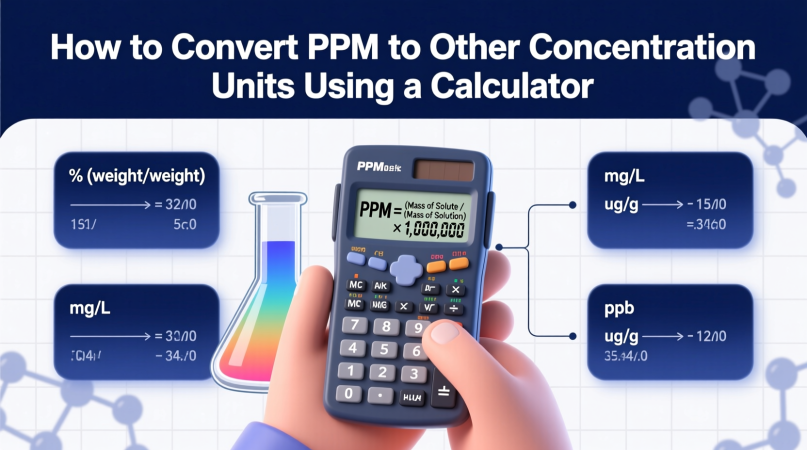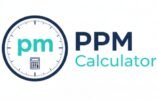
How to Convert PPM to Other Concentration Units Using a Calculator
Understanding how to convert PPM (parts per million) to other concentration units is essential for anyone working in water testing, chemistry, environmental science, or quality control.
Whether you’re a student, lab technician, or pool owner, mastering these conversions ensures accurate measurements and safe results. In this guide, I’ll walk you through the process, share practical examples, and show you how to use online calculators for fast, reliable answers.
Why PPM Conversions Matter
PPM is a widely used unit for measuring very dilute concentrations, especially in water and air. However, you’ll often need to convert PPM to other units like mg/L, %, ppb, or molarity, depending on your application. For example, water quality standards are usually set in mg/L, while fertilizer dosing in hydroponics might use PPM or EC (electrical conductivity). Knowing how to convert between these units helps you interpret results, comply with regulations, and avoid costly mistakes.
What is PPM?
PPM stands for “parts per million.” It expresses the ratio of one substance to a million parts of another. In water solutions, 1 ppm is typically equivalent to 1 mg of solute per liter of water (1 mg/L), assuming the solution’s density is close to that of pure water.
Common PPM Conversions
Let’s break down the most frequent conversions you’ll encounter:
PPM to mg/L (Milligrams per Liter)
- Formula:
mg/L = ppm - When to use: For dilute aqueous solutions (like drinking water or pool water), 1 ppm ≈ 1 mg/L.
- Example:
If your water test shows 50 ppm nitrate, that’s 50 mg/L nitrate.
PPM to Percent (%)
- Formula:
% = ppm ÷ 10,000 - Example:
500 ppm = 500 ÷ 10,000 = 0.05%
PPM to PPB (Parts per Billion)
- Formula:
ppb = ppm × 1,000 - Example:
2 ppm = 2 × 1,000 = 2,000 ppb
PPM to PPT (Parts per Trillion)
- Formula:
ppt = ppm × 1,000,000 - Example:
1 ppm = 1 × 1,000,000 = 1,000,000 ppt
PPM to Molarity (mol/L)
- Formula:
Molarity (mol/L) = (ppm × 10⁻³) / Molar Mass (g/mol) - Example:
For 100 ppm NaCl (molar mass ≈ 58.44 g/mol):
Molarity = (100 × 10⁻³) / 58.44 ≈ 0.00171 mol/L
Step-by-Step: Using a Calculator for PPM Conversions
Step 1: Identify Your Conversion
Decide which unit you need to convert PPM into. Are you working with mg/L, %, ppb, or molarity? Each has its own formula and context.
Step 2: Gather Required Information
- For mg/L, %, ppb, ppt: You only need your PPM value.
- For molarity: You’ll also need the molar mass of the substance.
Step 3: Use the Right Formula
Plug your values into the appropriate formula above. For example, to convert 250 ppm to percent:
% = 250 ÷ 10,000 = 0.025%
Step 4: Use an Online Calculator for Speed and Accuracy
Manual calculations are great for understanding, but online calculators save time and reduce errors—especially for complex conversions or when you need to switch between multiple units .
Try the PPM to mg/L Calculator or the PPM to Percent Calculator for instant results.
Step 5: Double-Check Assumptions
- For water solutions, 1 ppm ≈ 1 mg/L is valid when the density is close to 1 g/mL.
- For gases or non-aqueous solutions, check if temperature, pressure, or density adjustments are needed.
See PPM Formula Variations for details.
Practical Examples
Example 1: Converting PPM to mg/L in Water Testing
Suppose your pool test strip reads 3 ppm free chlorine.
Calculation:
mg/L = ppm = 3 mg/L
You can verify this with the Chlorine PPM Calculator.
Example 2: Converting PPM to Percent for Fertilizer
You want to know what percentage 1,500 ppm nitrogen is in your hydroponic solution.
Calculation:
% = 1,500 ÷ 10,000 = 0.15%
Try the Nutrient PPM Calculator for more fertilizer conversions.
Example 3: PPM to Molarity in Chemistry
You have a 58 ppm NaCl solution. What’s the molarity?
Calculation:
- Molar mass of NaCl = 58.44 g/mol
- Molarity = (58 × 10⁻³) / 58.44 ≈ 0.000993 mol/L
For more on this, see Molarity Calculator.
Quick Reference Table
| From (PPM) | To (Unit) | Formula |
|---|---|---|
| mg/L | mg/L | mg/L = ppm |
| % | % | % = ppm ÷ 10,000 |
| ppb | ppb | ppb = ppm × 1,000 |
| ppt | ppt | ppt = ppm × 1,000,000 |
| molarity | mol/L | (ppm × 10⁻³) / molar mass |
For a full table, visit the PPM Conversion Table.
Tips for Accurate PPM Conversions
Double-Check Units
Mixing up mg and g, or L and mL, is a common source of error. Always confirm your units before calculating. For more on avoiding mistakes, see PPM Calculation Mistakes.
Use the Right Calculator for Your Context
- Water testing: PPM for Water Testing
- Drinking water standards: Safe PPM Levels Drinking Water
- Lab work: PPM Best Practices for Lab Work
Understand the Limitations
Some conversions, like PPM to pH or PPM to NTU, are not universal and depend on the specific substance or calibration. Always check the assumptions or use calculators designed for your scenario, such as the PPM to pH Calculator with caution.
Frequently Asked Questions
What does 1 ppm mean in water?
In water, 1 ppm usually means 1 mg of solute per liter of water (1 mg/L), assuming the solution’s density is close to pure water.
Can I use the same formula for solids or gases?
Not always. For solids, 1 ppm = 1 mg/kg. For gases, you may need to account for temperature and pressure. See PPM Formula Variations for more.
Where can I find more calculators?
Explore the full suite of tools at PPM Calculator for conversions including TDS, EC, chlorine, and more.
Conclusion
Converting PPM to other concentration units is straightforward when you know the right formulas and use reliable calculators. Whether you’re testing water, mixing fertilizers, or working in a lab, these conversions help you interpret results and make informed decisions.

Dr. Robert is an industrial chemist specializing in process control, water purification, and quantitative chemical analysis. She has worked with environmental labs and manufacturing facilities to optimize solutions in parts-per-million (PPM) precision and safety compliance.
At PPMCalculator.com, Dr. Robert ensures the accuracy of each calculator and guide through peer review and data validation. Her mission is to make chemistry tools more reliable for engineers, researchers, and students worldwide.
Follow her professional updates on LinkedIn or contact via info@ppmcalculator.com. For More details, Click here
